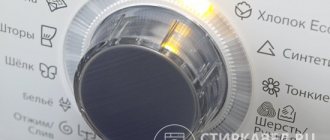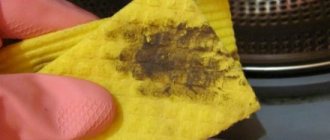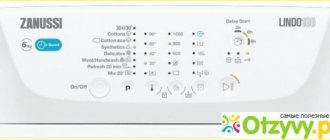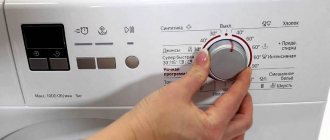Icons on clothes for washing are tips from manufacturers that will help ensure proper care of the product. There is a label with designations on the reverse side of the item. Understanding the meaning of the symbols, you can choose the right washing mode, ironing temperature and determine the possibility of dry cleaning or bleaching. What types of icons are there on clothes for washing and how they are correctly interpreted will be discussed in our article.
Icons on the clothing label will help you choose the right washing, drying and ironing modes, which will keep the item in its original form and extend its wear life.
The role of icons on clothing labels
Clothing manufacturers, taking care of consumers, indicate on the tags the rules for caring for the product. Special icons are used as a hint. They depict symbols that help you figure out how to wash things. General values:
- basin – washing mode and temperature;
- iron - ironing;
- circle – dry cleaning;
- triangle – whitening;
- square - drying.
A tag or tag is a small piece of fabric located on the wrong side of a garment. It is sewn into the side or back seam, and in shirts it is located in the collar area. Before washing, carefully read the label and determine the basic principles of care for the product. In addition to washing recommendations, the tag may contain other designations: size, type of material used, brand and country of origin.
Many people cut off the labels immediately after purchasing an item, due to the discomfort they cause. Once you cut off the label, do not throw it away. The information presented on it will be useful when the need arises to wash the product.
If the label causes inconvenience when wearing the product, cut it off, but do not throw it away. Save or take a photo of the tag - the information on it will help you choose the right way to care for the item.
Where to look for signs on things
Labels are usually sewn on from the inside out. On trousers this is the area of the hips, belt or pocket, on shirts - the side seam, skirts and dresses - the hem. Also, strips of fabric with markings are attached behind the collar. Pictograms are international symbols; the manufacturer is required to indicate them on each textile product.
Tip The location of the label is not always convenient: it either shows through or rubs. In this case, save or photograph the label after cutting it.
Wash
In order to follow label directions, it is important to know what they mean. First of all, you should understand the symbols regarding the washing mode and temperature. Below is a breakdown of the most popular icons.
A basin with a hand in it indicates the need for hand washing. In this case, the water temperature should not exceed +40 ℃. It is recommended to wash items made from delicate materials – silk, satin, chiffon – with your own hands.
A bowl of water indicates the possibility of washing and soaking the product. A crossed out basin is a ban on washing clothes at home. Such items should be dry cleaned to maintain their aesthetic appearance. As a rule, such designations are found on outerwear.
The washing machine, enclosed in a circle, eliminates the possibility of machine washing. Such designations are often found on products with a large number of decorative elements (beads, beads, rhinestones, sequins, etc.).
Numbers with the ℃ symbol indicate temperature conditions. The icon with the image +95 ℃ indicates the possibility of boiling the product. Sometimes black circles are used instead of numbers.
The explanation of symbols regarding washing is presented in the table:
| Image | Decoding |
| Recommended washing in cool water (+30 ℃) using neutral detergent | |
| The product can be washed in warm water (+45 ℃) using powder. Found on colored items made from polyester, cotton, melange and viscose | |
| Machine washable using hot water (+60 ℃) | |
| The number inside the water container indicates the temperature recommended for washing | |
| Washing clothes at home is prohibited | |
| The product is subject to careful washing. Spin at high speeds is prohibited | |
| Clothes should be washed in a delicate cycle, without using strong friction or spinning. | |
| Hand wash recommended |
How to properly process things if there is a prohibiting symbol?
bring clothes that are not machine washable into proper condition as follows:
- Fill a basin or bath (if there are a lot of dirty things) with warm water (temperature no higher than 30C).
- A measuring cup of washing powder (liquid detergent or gel) is diluted in water. As an option, you can use grated laundry soap (3-5 tablespoons of shavings are enough for 10 liters of water).
- Soak dirty laundry in the resulting soap solution for five to ten minutes.
- With careful movements, things are taken out and lowered into the water; especially contaminated areas are lightly rubbed with your hands.
- Fill a separate container with clean cold water in which to rinse the laundry.
If the “machine wash prohibited” symbol is indicated on the tag, then such items cannot be actively twisted, squeezed, or pulled. Wring out such products in a terry towel. To do this, lay the clothes on a towel, then carefully roll them and squeeze them thoroughly.
Spin
It is also important to pay attention to the recommendations regarding spinning the product. An incorrectly selected mode will lead to deformation of the fabric. Spin icons:
| Image | Decoding |
| Spinning in an automatic washing machine is prohibited | |
| Spinning in an automatic washing machine is allowed, including at high speeds | |
| Automatic gentle spin allowed | |
| Automatic gentle spin allowed | |
| Twisting and wringing of products is prohibited. These things should drain and dry naturally. |
How to enable and use the option?
Spin is a function that is included in most washing programs and occurs as follows:
After the wash is completed, the water is drained. The laundry still remains very wet.- The spin cycle starts automatically at a certain intensity.
- The drum begins to rotate at high speed. The removal of moisture from things occurs due to centrifugal force - things in the drum are strongly pressed against the walls.
- The water squeezed out of the laundry is pumped out of the tank using a pump into the sewer system.
This process is quite noisy. This is due to the intense rotation of the drum and the operation of the pump.
Most washing machines allow you to adjust (downward) the spin intensity when choosing standard modes. When the indicator decreases, the laundry will remain more damp than with more intense exposure.
Most equipment manufacturers provide the ability to select spin as a separate program. This is a convenient option; with its help, it is possible to squeeze out items that remain very wet after the standard processing cycle.
You don’t even have to take them out of the drum , but immediately select the “spiral” icon on the control panel.
It is also possible to use the “spin” for hand-washed laundry. Wet items are simply placed in the drum, and the “spiral” is selected on the control panel. At the same time, the intensity of laundry processing can (and even should) be adjusted taking into account the type of fabric and type of items.
Even a powerful washing machine has the ability to select a low speed. This may be necessary when processing delicate, light fabrics that can become deformed, wrinkled, or even tear when the drum rotates intensively. Rotating the drum at high speeds will undoubtedly make the thing drier, but it can also ruin it.
The video will show you how to set only “Spin” on an LG washing machine:
Drying
After washing, it is important to choose the right drying mode. The markings on the label will also help with this.
| Image | Decoding |
| The product can be dried in an automatic machine or by hanging it on a line | |
| Automatic drying prohibited | |
| Horizontal drying of the product is allowed. This option is suitable for wool and knitwear. | |
| The product must not be twisted, but must be dried in a vertical position. | |
| Clothes should not be dried in direct sunlight | |
| Clothes should not be dried in direct sunlight; drying in a horizontal position is recommended. | |
| Drying vertically in the shade is allowed | |
| Line drying allowed | |
| Drying vertically in the shade is allowed | |
| Low temperature drying allowed | |
| Drying allowed at medium temperature | |
| High temperature drying allowed |
Letter marking
In addition to graphic signs, there are markings in English. Let's look at the meaning of these inscriptions.
Table 6. Translation of English symbols
| Hand wash only | Hand wash only |
| Machine wash | Machine washable |
| No wash or Do not wash | Can't wash |
| Don't dry clean | Dry cleaning is prohibited |
| Don't bleach | Do not bleach |
| Wash separately | Wash separately from other items |
| Don't iron | Do not iron |
| Don't wring or twist | Do not squeeze, do not twist |
| Don't tumble dry | Machine drying is prohibited |
| Dry in shade | Dry in the shade |
Ironing
The labels on clothes for washing will also help you choose the optimal ironing mode. To avoid damaging the material during ironing, be sure to follow the recommendations on the labels.
The image of an iron indicates the ability to iron the product with an iron or press. For such clothes, it is permissible to use high temperatures and use steaming. The number of circles inside indicates the temperature regime - from minimum (1 circle) to maximum (3 circles).
A crossed out iron indicates that ironing is prohibited. Often such an icon is depicted on products made of nylon and terry. The crossed out bottom of the iron indicates that steaming is prohibited. This symbol is found on silk and satin clothing.
Explanation of icons:
| Image | Decoding |
| Can be ironed | |
| You can't iron | |
| Allowed to iron at high temperatures (up to +200 ℃). Suitable for ironing cotton, linen and textiles when wet. Only in this mode can you steam clothes | |
| Ironing is allowed at medium temperature (up to +150 ℃). Suitable for ironing cotton, silk, wool, polyester, viscose. Iron using a slightly damp cloth or an iron with a steam humidifier. | |
| Allowed to iron at low temperatures (up to +110 ℃). Suitable for synthetic fabrics: polyacrylic, polyamide, polyester, acetate | |
| Steaming is prohibited |
Some general care tips
If you follow all the recommendations on the label, problems usually do not arise, but there are also additional tricks:
- Separate white, multi-colored, black and red - separately, these piles better retain their shade.
- Wash synthetics, wool and cotton separately, even if they are specified at the same temperature - they need different wash times, and the cotton lint wraps around the synthetic fibers, causing both materials to form pills.
- Be sure to check your pockets! Accidentally forgetting a notebook for notes after one wash will disfigure the entire load of laundry with small specks of paper crumbs, which will take a long time to clean off with a vacuum cleaner or clothes roller. And coins or nails will leave a legacy of rusty stains. The handles are not worth mentioning. These spots are unlikely to go away quickly.
- It is better to turn tights, socks, knee socks and generally all knitwear, including T-shirts, inside out - this way there will be fewer pills or they will hide on the inside out.
- Never wash clothes with shoes.
- If the item is delicate and has accumulated a lot of dust, so that a short cycle will not cope, do not add either time or washing gel - this will damage either the item or the device. Throw special laundry balls or 3-4 white tennis balls into the drum.
Features of the first wash
Instructions for the first washing of clothes from experienced housewives:
- For color: soak the item for several hours in paint protectant or saline solution.
- Dissolve the powder or gel well when hand washing.
- Wash the item separately from others.
- To check if the fabric is fading, wet a small area with warm water and wring it out. Sometimes the manufacturer includes a fabric sample along with the label, experiment with it.
All icons on the labels are conveniently structured, so now you won’t get confused in the basic designations. And complex additions can always be seen in this article.
Whitening
If the product needs to be bleached, first read the instructions on the label. A prohibition on the procedure is indicated by a white or black triangle crossed out with two lines. Failure to comply with the recommendation may result in damage to the material.
An empty triangle indicates that bleaching is acceptable. The “Cl” symbol allows the use of chlorine-containing detergents. A triangle with three parallel lines - bleaching without the use of chlorine is acceptable.
Dry cleaning
On the label, the dry cleaning icon is indicated by a circle. A detailed explanation of such symbols is presented in the table:
| Image | Designation |
| Dry clean only | |
| Dry cleaning prohibited | |
| Can be dry cleaned using any solvents | |
| Dry cleaning using hydrocarbons or trifluorotrichloromethane is allowed | |
| Gentle dry cleaning using hydrocarbons or trifluorotrichloromethane is allowed | |
| Delicate dry cleaning using hydrocarbons or trifluorotrichloromethane is allowed | |
| Dry cleaning with hydrocarbons, monofluorotrichloromethane and chlorine is allowed | |
| Gentle dry cleaning using hydrocarbons, monofluorotrichloromethane and chlorine is allowed | |
| Delicate cleaning with hydrocarbons, monofluorotrichloromethane and chlorine is allowed |
Also on the label you can see the image of a “W” in a circle. This symbol indicates the possibility of aqua-cleaning. The meaning of the icon can be seen in the photo:
The “W” symbol enclosed in a circle indicates that wet cleaning of the product is possible or prohibited.
Dry cleaning (dry cleaning and wet cleaning)
The circle indicates recommendations for professional dry cleaning. We decipher the letters and icons:
- Empty circle - dry cleaning is allowed.
- Crossed out - prohibited.
- Inside the letter “A” - cleaning with any solvent.
- Inside the letter “P” - procedures with hydrocarbons, ethylene chloride, and monofluorotrichloromethane are allowed. An additional horizontal line under the circle means a more gentle regime with the same solvents.
- Letter “F” - tetrachlorethylene and hydrocarbons are allowed. An additional feature is the delicate mode with the same solvents.
Don't bother with dry cleaning icons unless the circle is crossed out. A service employee will figure out how to clean a delicate item.
Table 2. Dry cleaning icons
| Dry cleaning allowed |
| Dry cleaning is prohibited |
| Any solvents |
| Regular or delicate whitening with substances approved for R |
| Regular or delicate whitening with substances approved for F |
“Water cleaning” is separately designated. You'll recognize these guidelines by the letter "W" inside the circle:
- No additions - water cleaning is allowed.
- A crossed out circle with a “W” or a crossed out filled circle means water cleaning is prohibited.
- One horizontal line under the circle is a gentle water cleaning.
- The double feature is the most delicate water cleaning mode.
Table 3. Icons for water cleaning
| Professional water cleaning allowed |
| Gentle water cleaning mode |
| Maximum gentle cleaning |
| Water cleaning is prohibited |
General recommendations
If there is no label, follow the general washing recommendations:
- Wash products made from synthetic materials separately from natural ones;
- separate items into white, colored and black and wash them separately;
- take into account the material of the product when choosing a program and washing mode;
- do not set high spin speeds;
- dry products in an automatic machine only in exceptional cases;
- Use bleach and dry cleaning with extreme caution and only as a last resort.
Before washing, be sure to sort dirty laundry, taking into account not only the color of the items, but also the composition of the fabric
If the label is missing or you cannot correctly decipher what the icons on the clothing mean, take into account the material of the product. Wash delicate fabrics (silk, viscose, velvet, etc.) by hand at a water temperature of +30 ℃.
Wool items can be washed by hand or in an automatic machine on a delicate cycle. For washing, use cool water and special detergents.
Cotton tolerates any type of care well, so you can safely wash it in a convenient way using classic powder. Synthetics do not tolerate high temperatures, so when cleaning, do not use hot water or a very hot iron.
To select the optimal washing mode, you can use special programs in the washing machine.
If there are no icons on the clothes, determine the type of fabric of the item and use special programs in the washing machine
What are they for?
When purchasing outfits, most people do not look at the manufacturer's care recommendations. But in vain. For example, how are you going to clean a coat that only requires dry cleaning if you live in a small village where there are no such establishments? If you don't follow the rules, the item will quickly lose its attractiveness.
For good appearance and long service life, textiles must be washed with a suitable washing powder.
The symbols that are applied to the label are universal and are adopted in many countries at the legislative level. Therefore, they are mandatory in textile factories.
The label itself is a piece of fabric sewn to the product in an inconspicuous place on the reverse side. In addition to information on how to wash, it most often provides information about the manufacturer and composition of the fabric.
Many people cut off these tips because the tag can be uncomfortable to wear. In this case, it is better to save the label and return to the care instructions as needed.
To avoid turning your home into a warehouse of cut-off labels and to avoid getting confused about which item belongs to which, use this simple advice. Before cutting off the tag, take a photo of it together with the item, and it will be clear which dress or sweater it is sewn on. And when you need information, just find the photo you need in the memory of your phone or camera.
In the following sections we will get acquainted with the symbols that appear on the tags.
Table of decoding icons on clothes
Manufacturers may use different symbols to indicate the same care instructions. Below you can see the table of symbols on clothes for washing:
The table presented contains the most popular and frequently used designations by manufacturers. The ability to decipher them will help ensure that things are properly cared for.











